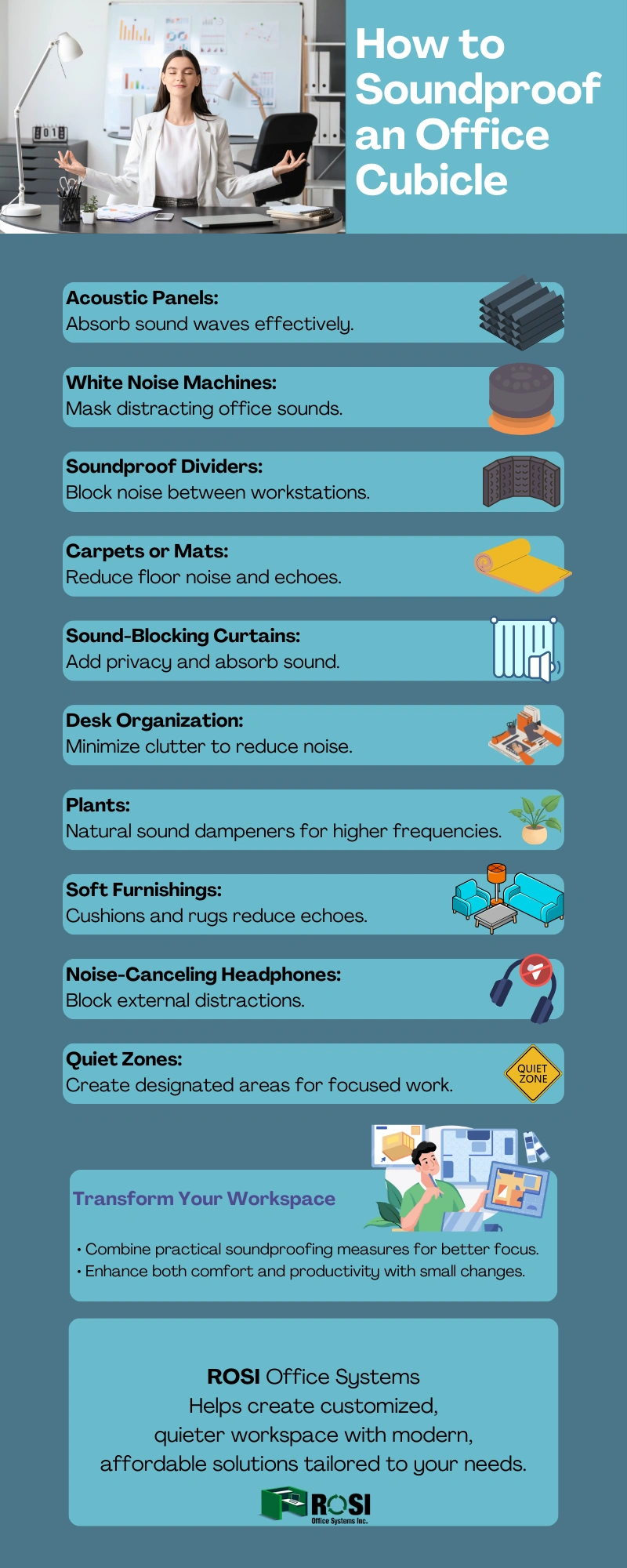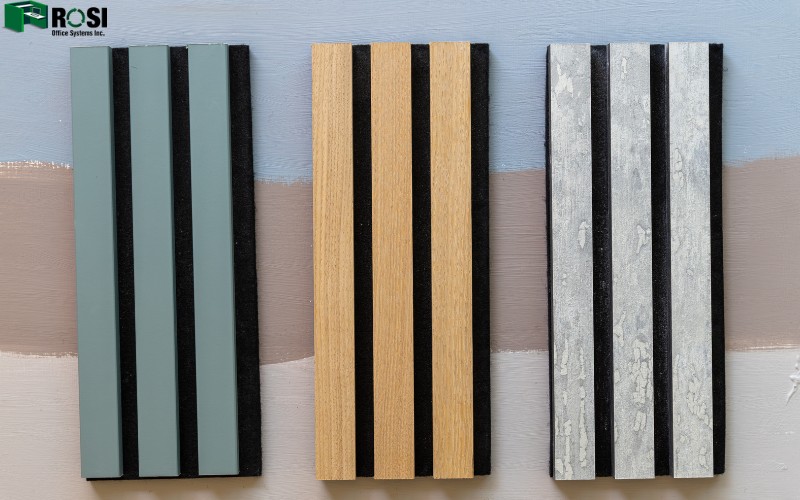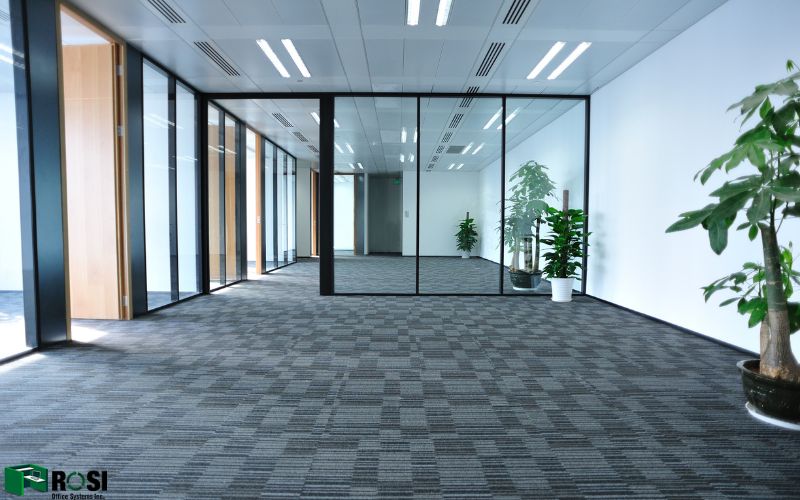
In work environments, calmness and focus on tasks are some of the most important factors in productivity.
Imagine that you are immersed in work in your cubicle during a typical work day and suddenly your colleague’s phone call distracts you or two colleagues talking in the next cubicle disrupt your concentration.
In this situation, work is delayed and the stress level of employees increases.
Therefore, improving the acoustic conditions in office cubicles is always one of the important concerns of managers and employees in businesses.
Because noise not only negatively affects a person’s performance, but also harms their mental health and well-being.
Therefore, employees need to work in quiet and soundproof cubicles to increase their productivity and job satisfaction.
Now the question is How to Soundproof an Office Cubicle? Soundproof an office cubicle by adding acoustic panels or foam to the walls and ceiling to absorb noise. Use noise-canceling headphones or desk dividers to block distractions. Install heavy curtains or fabric-covered partitions for added sound insulation. A thick rug or carpet can help reduce sound reflections and create a quieter workspace.
Let’s look at the top 10 ideas for soundproofing an office cubicle comprehensively!
How to Soundproof an Office Cubicle: Top 10 Ideas

1. Use Acoustic Panels or Foam

Installing acoustic panels or foam can be very effective in reducing noise pollution in office cubicles. They are very easy to install and have a high sound absorption capacity.
Acoustic wall panels are designed to be rigid or semi-rigid and prevent sound reflection and sound waves from spreading in closed spaces.
By installing them on the walls of cubicles, sounds, especially loud sounds, are absorbed and excess noise in the environment is minimized.
This feature is especially effective in cubicles that are located near high-noise areas such as telephone areas or meeting rooms.
In addition to acoustic panels, you can use special foams that are attached to the cubicle walls.
Foams are also able to absorb ambient sounds to a great extent and reduce noise.
Foams are light and flexible, and their installation is very easy and can be easily implemented in any type of workspace.
Acoustic panels and foams can be installed in a combination in private office cubicles to allow employees to experience clearer communication with fewer distractions.
Using acoustic panels and foams as an effective and affordable solution has a great impact on improving the quality of work and the well-being of employees in busy and noisy environments.
By doing this, it is possible to create a space that, in addition to reducing noise, helps increase job satisfaction and improve the work environment.
You Might Also Enjoy: Top Modern Office Trends
2. Install Noise-Canceling Curtains
Another idea that can be used to answer the question of how to soundproof an office cubicle is to use soundproof curtains.
Soundproof curtains are an efficient and effective choice for reducing noise pollution. These curtains are made of special materials that have the ability to absorb and block sound.
By installing them around office cubicles, you can protect your space from annoying external sounds such as phone calls from colleagues.
These curtains not only prevent external sounds from entering but also from sounds such as traffic, the sound of office equipment, and people talking in the hallways.
Soundproof curtains are suitable for those who work in busy environments and need a quiet environment to perform their tasks.
These curtains acoustically isolate the space and separate the cubicle space from noise. So employees can perform their tasks in a quiet environment and with high concentration.
3. Add Rugs or Carpets to the Floor
Using carpets and rugs on the floor is another effective way to soundproof an office cubicle. Surfaces with ceramic, wood, or concrete coatings easily reflect sound and spread sound waves throughout the space.
As a result, people’s concentration is lost and the environment seems noisy. However, you can place a rug on the floor of the room and prevent sound reflection to a large extent.
Carpets have a soft texture and can absorb sound waves and neutralize them. Various sounds in the environment are easily absorbed by the carpet, and as a result, sound reflection in the space is reduced.
In addition to the carpet, you can place a suitable pad under the carpet to absorb sound more effectively.
This additional layer has a significant effect on absorbing surrounding sounds and preventing annoying noises to the desired extent.
These changes are indeed small, but they are very effective and help create a calmer and more suitable environment for work and concentration.
4. Use White Noise Machines or Sound Masking
The purpose of using a white noise machine or masking system is to mask a wide range of surrounding noises.
This idea is one of the best ways to soundproof an office cubicle. The function of a white noise machine is to produce a constant and monotonic sound and cover up annoying and unnecessary environmental sounds such as the sound of the telephone and colleagues.
This sound is neither too loud nor too gentle and is not annoying to the human ear.
This device masks other sounds and background noise that distracts the person is less heard.
Therefore, a person’s concentration in busy environments increases and stress caused by environmental noise is reduced.
These devices have features that allow users to adjust the intensity and type of white noise according to their needs.
Some devices also can play nature sounds such as the sound of rain or the sea, which provides a relaxing experience for many.
5. Consider Soundproofing the Ceiling
The ceiling is also one of the factors that causes ambient sounds to reflect. Usually, ceilings are made of concrete or plaster, which are not able to absorb ambient sounds, so they are easily transmitted.
Especially in office cubicles that are close to each other and can hear each other’s conversations.
Even the sound of people walking in the hallways is reflected into the space through the ceiling, and disturbing sounds can negatively affect the quality and mental health of people.
Installing acoustic ceiling panels is the best way to solve this problem. Ceiling panels easily absorb ambient sounds and prevent sound reflection.
Finally, using this method, cubicle space can be soundproofed and transformed into a quieter and more suitable environment for performing complex tasks that require high concentration.
6. Install Soundproofing Partitions

It’s natural for some areas of an office to produce more noise than others. Phone calls, group meetings, and everyday conversations between colleagues are all noises that can be disruptive to people who need to concentrate.
This problem is especially noticeable in open-concept offices without dividing walls, where sound can easily spread throughout the room and disrupt employees’ concentration.
For these spaces, soundproof partitions can be installed to limit noise. Soundproof partitions, which come in a variety of lengths from short to floor-to-ceiling heights, can create a temporary wall to contain sound when needed.
These sound barriers are easy to install and move and can be moved to another location or new workspace configurations as needed.
This flexibility in the use of partitions is very useful for offices that need to change quickly.
They allow employees to focus on their tasks and be more productive without being disturbed by surrounding noise.
7. Use Noise-Canceling Headphones
Another great idea for soundproofing an office cubicle is to use earplugs or noise-canceling headphones.
These headphones use advanced technologies to block out ambient noise and provide a quiet space for the person.
Noise-canceling headphones come in different models and types, each designed for different work environments.
Using these headphones is very effective in busy work environments and can increase a person’s concentration.
Employees can also listen to their favorite music while working. By listening to music, you can continue working more creatively and with more motivation.
You Might Also Enjoy: Top 10 Office Cubicle Music To Boost Productivity [2025]
8. Seal Gaps in the Walls
In some office cubicle designs and structures, gaps and small gaps in the walls can be a way for ambient sounds to enter.
These gaps allow even gentle and weak sounds to pass through, allowing disturbing sounds to easily penetrate the cubicle.
To solve this problem, special materials can be used to seal these gaps. Sealing strips are one of these options for blocking sound and preventing it from penetrating into the cubicle.
Acoustic sealants are also another option that can be used to insulate gaps. Acoustic sealants are made of silicone or latex compounds that you can easily place around edges and seams and seal them tightly.
These materials help improve the overall acoustic quality of the work environment by blocking sound.
This idea can work more effectively alongside other methods we have suggested, such as installing acoustic panels or using soundproof partitions, and make the workspace a quieter environment to perform work tasks.
Ultimately, using this method, it is possible to create completely isolated spaces in office cubicles without noise pollution.
9. Rearrange Your Cubicle Layout
The way cubicles are arranged in a workspace can have a significant impact on reducing noise and sound pollution.
The cubicle layout should be designed to be away from noisy equipment such as printers and fax machines.
These devices should not be near meeting rooms or rooms where people make phone calls because their sounds mix with the surrounding noise and create an unpleasant work environment.
In addition, the way desks and seating areas are arranged should be such that the backs of the employees are too noisy areas such as entrance doors.
Office cubicles should be placed so that the surrounding noise does not directly hit them so that less noise reaches their ears.
In general, by reviewing the arrangement of cubicles and the location of equipment and desks, an environment can be created that is more acoustically optimized.
These seemingly simple changes can have a big impact on employees who need a quiet space and focus and make a big difference in the quality of their work.
10. Use Soft Materials for Office Furniture
Using soft fabrics for office furniture is another suggested idea for soundproofing an office cubicle.
Office furniture with fabric upholstery both beautifies the space and has a high ability to absorb sound and reduce ambient noise.
Therefore, using this furniture significantly reduces ambient noise and makes the environment calm and pleasant.
Soft and fabric materials can act as sound insulation in spaces where there is a lot of noise and commotion, such as offices or meeting rooms.
These materials prevent sound from reflecting in the space by absorbing it and greatly help in improving the acoustic quality of the environment.
Fabric materials cause the sounds produced in the environment to be absorbed in their textures instead of reflecting in the walls and ceilings.
This idea is very important in spaces that have surfaces with high sound reflection, such as concrete or glass walls.
Conclusion
Building a soundproof cubicle and creating a quiet environment in today’s offices is an important factor in increasing productivity and maintaining the mental health of employees.
The need for peace is felt more in very busy offices, as well as in people who do complex tasks and need to concentrate.
In our article How to Soundproof an Office Cubicle, we introduced the top 10 ideas to effectively create a quiet environment for your employees.
Measures such as installing partitions, using soft coverings such as carpets and fabric office furniture, etc. are among the things that can make a significant difference in the noise level of the cubicle space.
In some cases, using soundproofing materials and installing double-glazed windows or using acoustic ceilings can be a great help in controlling sound and preventing it from reflecting into the office cubicles.
Therefore, investing in soundproofing office cubicles by increasing employee productivity can become one of the key strategies for success in the business world.

John Ofield is a recognized expert in the office furniture and office cubicle industry in Houston, TX, with over 40 years of experience. As the founder of ROSI Office Systems, he specializes in furniture space planning, custom cubicle designs, modern office chairs and tables, and high-quality commercial furniture. John’s expertise helps businesses enhance productivity and collaboration. He is also dedicated to mentoring entrepreneurs and redefining workspaces to inspire success.